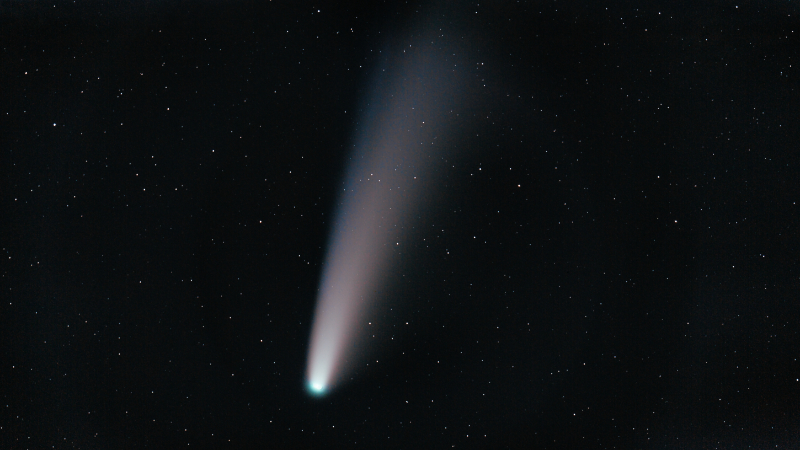| 2020 Jul 14-19: Comet Neowise at its best (2020-6-27) ⬅︎ |
 |
Comet Neowise, technically C/2020 F3 NEOWISE. Photographed July 16 from Starry Hill. Notice the
greenish head, or 'nucleus', is flattened. This is because the comet was moving so fast right-to-left during the 7
minutes of exposures. Most of the tail is dust and glowing from reflected sunlight. But look carefully on the left
side of the tail, the part that is bluish -- it is the 'ion' tail and consists of gases glowing due to ionization.
What is a comet? Comets are often referred to as 'dirty snowballs' since they are made mostly of a mixture of ice
and dirt. Compared to stars and planets, comets are small -- a large one might be no bigger than Mt Rainier. Most
are found in the distant regions of our solar system known as the Kuiper Belt and Oort Cloud.
Some comets have orbits that bring them close to the sun. When this happens, the comet can start to melt and
break apart. The sun's powerful wind, known as solar
wind, can blow the loosened debris away from the comet forming a tail that can extend millions of miles
from the comet's body, or nucleus. That tiny comet can become an enormous, spectacular sight in Earth's
sky.
Keep in mind that a comet's tail doesn't indicate the direction in which the comet is traveling. Rather, it shows the
direction of the solar wind which is always outward, away from the sun.
Comet Neowise was first spotted in March 27 by a NASA spacecraft. The best viewing from Earth is now, July, as
the comet swings around the sun and makes it closest approach to us before returning to
deep space. How long will the tail be? How bright? We won't know until it happens.
If you want to see Neowise, it will be important to time things just right. You'll also need a location with an
unobstructed view
of the N horizon and, preferably, far from city
lights. It can be spotted naked-eye now, but we recommend using a binocular to get the best view. A telescope will
allow you to view details.
Dates
* July 3: comet at perihelion (closest point to sun at 28 million miles). Cannot be viewed.
* July 11-13: best morning viewing. Look to the NE around 4am. Look below bright Capella. Neowise will be about
10° above the horizon (a fist held at arm's length). It will rise higher and higher but the sky will also be brightening
as twilight begins and leads to sunrise around 5:30am. A fairly bright Last Quarter moon will add to the challenge.
* July 14-19: best evening viewing. Neowise will be too low for morning viewing but it will be well-positioned for
evening viewing. On
the 14th, it will be 10° above the horizon around the end of twilight, and, by the 19th, it will be 20° in altitude. Also,
the moon won't be in the way.
* July 22: Neowise will be closest to Earth (perigee), 64 million miles. For reference, the distance from Earth to the
sun is 93 million miles.
* Late July and beyond: although it should be possible to spot Comet Neowise for the rest of July and August, a
telescope may be needed. This is because it will be getting dimmer rapidly as it pulls away from both
the sun and Earth.
Be sure to check out our Star Guide feature with its tools for knowing what's out each night and where to
look.
|
| |



